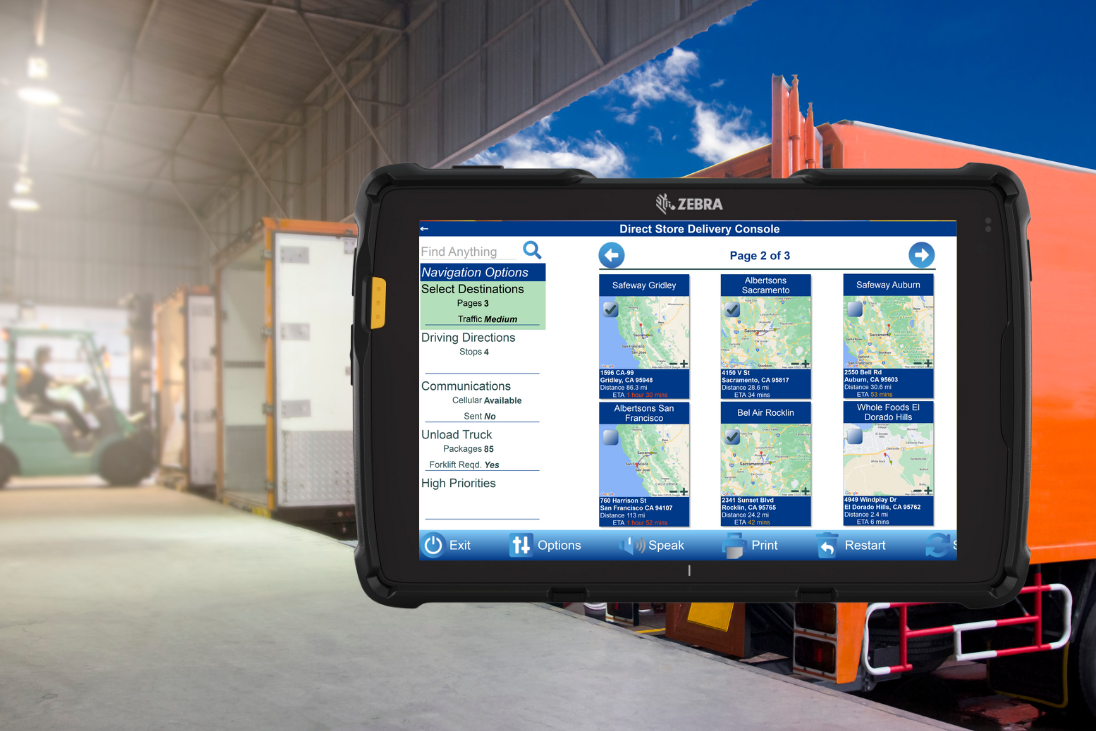Don’t Neglect Maintenance Inventory Levels in MRO (Maintenance, Repair, and Operations) Space
- Asset Tracking
- Inventory/Warehouse
- MRO
In today’s supply chain, warehouses and production plants rely on the continuous operation of equipment to keep inventory flowing. This equipment demands regular maintenance. But without adequate stores of maintenance inventory, equipment breaks down, leading to inconvenient—and potentially costly—interruptions to the organization.
For this reason, Maintenance, Repair, and Operations (MRO) stands as a silent sentinel ensuring the smooth functionality of systems and processes throughout the supply chain. Adequate stocking of spare parts, consumables, and tools is required. Maintaining oversight on these stocks is easier said than done, however. But it can be done!
Understanding Inventory Used in Maintenance
Inventory levels in maintenance and repair play a critical role in ensuring the smooth functioning of equipment. Each type of material commonly used in MRO requires sufficient levels to prevent operational disruption in the face of production demand, reduce costs associated with emergency orders, and enhance overall business performance.
Spare parts (“maintenance spares”) are needed for industries heavily reliant on machinery, such as manufacturing, transportation, or utilities. Quick access to maintenance spare parts is vital to replace damaged or faulty components. Proper inventory levels of spare parts ensure that repairs and replacements can be executed swiftly, reducing downtime, and minimizing the impact on production and human safety.
Consumables inventory, like lubricants and glue, are used up during regular operations, ensuring machinery continues to function properly. This avoids delays caused by shortages and guarantees a safe and efficient working environment without loss of productivity.
Fixed assets must be accurately tracked, stored, and located for use in projects large and small. Fixed assets can take the form of equipment, tools, vehicles, and even high-value spare parts.
Together these three types of maintenance inventory make up the bulk of materials used in MRO.
However, other types of maintenance materials that may need to be kept on hand include:
- Expendable Inventory: Similar to consumables, expendables like single-use protective equipment and cleaning solvents are used up during maintenance and then discarded. These items are consumed during routine maintenance activities and need to be replenished regularly.
- Critical Inventory: Absolute essentials to operations. Often specialized components for unique processes. Insufficient critical inventory impacts operations the most.
- Rotable Inventory: Components removed from equipment during maintenance or repair and then replaced with refurbished or repaired items. Often sent to specialized repair facilities before rotating back into inventory once refurbished.

ALSO READ: How Asset Tracking Enhances Operations and Boosts ROI
READ NOW »Why Maintenance Inventory Levels Are Important
Having enough MRO inventory on-hand acts as an assurance for the seamless continuation of operations.
Picture a manufacturing plant operating at full capacity. Without a well-maintained inventory of spare parts, even a minor equipment failure could lead to significant downtime. The availability of the necessary parts on-site can mean the difference between a quick fix and hours or even days of halted operations. This is the assurance that maintenance inventory management provides.
Despite its importance, maintenance strategy is one of the last components companies invest in and prioritize. This is surprising considering that an ill-timed shortage can disrupt schedules, leading to delayed deliveries, unsatisfied customers, and dented reputations.
But the impact isn’t merely operational. Financial implications can be just as severe. Extended downtimes can lead to significant revenue losses, and urgent procurements often come at a premium.
Additionally, regular equipment breakdowns due to lack of timely maintenance can reduce the equipment’s lifespan, necessitating more frequent and costlier replacements.
Some of the most significant issues that business leaders experience with spare parts inventory include:
- Equipment or production downtime
- Inaccuracy and inefficiency
- Losing track of the placement of parts and inventory
- Lack of understanding of parts usage patterns
- Overspending on items that are not low in stock

How to Achieve Flawless Fixed Asset Tracking with Mobile Barcoding
DOWNLOAD NOW »The Pitfalls of a Manual Tracking System
Many maintenance operations still conduct inventory management manually, either using paper-based processes, spreadsheets, or no system at all. While this may be easier for some workers with tribal knowledge, it’s problematic in many ways for the organization. Manual maintenance processes are highly inefficient and inaccurate compared to automation.
Manual maintenance parts tracking is only 60% accurate at best. Accuracy translates directly to cost. According to the white paper, Investing in Warehouse Innovation, the average inventory error incurs a cost of $50 to $500 in overhead costs. Many errors per day drive up overhead costs in a way that is unsustainable without holding back the organization.
Additionally, the inability to effectively replenish inventory leads to stockouts and last-minute emergency ordering, further impacting budgets and production schedules.

READ NOW: Investing in Warehouse Innovation
DOWNLOAD GUIDE »When MRO activities aren’t automated, harmful outcomes abound:
- Excessive downtime, which can lead to increased spending and decreased earnings.
- Inability to make products on time can cause orders to go unfinished. Incompetence in the industry can lead to distrust from clients and a negative reputation.
- Ordering items before they are needed can lead to overstocking, which can lead to waste or disorganized storage.
- Delayed production can lead to rushed shipping to clients. Organizations might need to pay steep overnight shipping costs, which can add up to thousands of dollars.
- Malfunctions can cause workplace injuries or even loss of life.
Best Practices for MRO Inventory Management
Strategic forecasting and planning sit at the apex of effective MRO inventory management. Predictive analytics tools have become indispensable in this realm. Just as importantly, real-time inventory control with live consumption and issue-to-project functionality enables optimal governance.
Similarly, well-timed inventory replenishment methods ensure materials never run out.
When it comes to documentation, the ability to access crucial information on-demand, both on-site and off-site, is essential to streamlined maintenance and repair operations.
To achieve these proactive and continuous strategies, technology remains key. The right mobile maintenance inventory management software can significantly increase the flexibility and productivity of maintenance technicians. Such technologies can equip workers with built-in best practices to ensure accurate work that is both safe and efficient at all times.

Jumpstarting Your Digital Transformation Journey in MRO
LEARN MORE »The Benefits of Maintenance Inventory Software
Automated MRO platforms can save your organization time, money, and resources. Switching to a mobile-based MRO inventory platform can improve efficiency, productivity, and flexibility of everyday operations in the warehouse.
A mobile inventory solution for maintenance activities can equip your operation with the same level of granular oversight and control as a high-performing distribution center. Mobile work order management drives faster, safer, more accurate repairs, even in the field.
Since manufacturing work occurs around the clock and involves many moving, changing parts, automated systems that operate on mobile devices connected to your ERP system are the best way to maintain uptime.

Embracing Mobility Essential in MRO, Field Services Operations
READ NOW »One of the most significant advantages of an automated MRO platform is its ability to order new parts and products from suppliers as soon as they are used. Replenishment can be predicted and automated based on consumption metrics. This keeps inventory levels accurate and consistent, which will in turn prevent overstocking and under-stocking.
When warehouses use manual inventory tracking practices, they incorporate more manual, hands-on labor than is necessary. In addition, organizations might experience issues related to human error, such as accuracy and data entry problems.
Manual entry also means the data is not updated instantly—organizations may not see updates in the system until the following business day. When a machine breaks down, lack of parts may lead to rush ordering. Even a simple clerical error causes production to stop and the organization to spend thousands of dollars on shipping.
Most importantly, having a dedicated MRO management solution enables companies to focus on their business priorities and functions rather than using manual labor on inventory maintenance. This provides more uptime for organizations to do what they do best: produce excellent materials.

3 Key Benefits of Mobile Work Order Management for MRO
DOWNLOAD NOW »The Way Forward: Incorporating Mobile Technology for MRO Inventory Management
Technological advancements have ushered in a new era of MRO inventory management. Systems like mobile maintenance and barcoding have revolutionized the way businesses manage their MRO inventory.
Going mobile provides employees with an all-in-one system that connects to your existing software environment, enabling real-time inventory visibility. Tracking, ordering, and maintaining inventory items becomes reliable and effortless.
RFgen provides inventory visibility and management in the MRO space with multiple ERP systems, such as:
- SAP S/4HANA
- Oracle Fusion Cloud SCM
- Oracle’s JD Edwards
- Oracle E-Business
- Deltek Costpoint
- Microsoft D365 F&O/SCM
These platforms have maintenance modules that can track upkeep procedures and the history of machines as they are serviced over time. By mobilizing these activities, technicians can operate at point-of-work with real-time access to critical information needed to perform successful maintenance safely and efficiently.
The Next Step: Streamline MRO with Mobile Software
MRO inventory might not always be in the limelight, but its importance in ensuring operational continuity is undeniable. In the ever-evolving landscape of the supply chain, adopting a strategic, automated approach to inventory control in maintenance can be the linchpin for success. Mobile maintenance solutions for inventory management offer real-time access to data, facilitating instant decision-making and ensuring operations run unhindered. Automation of repetitive tasks coupled with the flexibility of a mobile system enhances efficiency and optimizes resource allocation.
As technology continues to redefine boundaries, businesses that leverage it while adhering to inventory management best practices will reduce overhead costs, improve equipment uptime, and elevate customer service.




